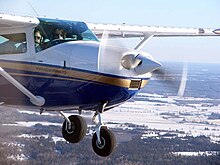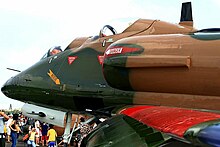
Back مولد الزوابع Arabic Generador de vórtices Spanish مولد گردباد Persian Générateur de tourbillons French Pembangkit pual ID Generatore di vortici Italian ヴォルテックスジェネレータ Japanese Virvelgenerator NB Turbulizator Polish Gerador de vórtice Portuguese





A vortex generator (VG) is an aerodynamic device, consisting of a small vane usually attached to a lifting surface (or airfoil, such as an aircraft wing)[1] or a rotor blade of a wind turbine.[2] VGs may also be attached to some part of an aerodynamic vehicle such as an aircraft fuselage or a car. When the airfoil or the body is in motion relative to the air, the VG creates a vortex,[1][3] which, by removing some part of the slow-moving boundary layer in contact with the airfoil surface, delays local flow separation and aerodynamic stalling, thereby improving the effectiveness of wings and control surfaces, such as flaps, elevators, ailerons, and rudders.[3]
- ^ a b Peppler, I.L.: From The Ground Up, page 23. Aviation Publishers Co. Limited, Ottawa Ontario, Twenty Seventh Revised Edition, 1996. ISBN 0-9690054-9-0
- ^ Wind Turbine Vortex Generators, UpWind Solutions.
- ^ a b Micro AeroDynamics (2003). "How Micro VGs Work". Retrieved March 15, 2008.
© MMXXIII Rich X Search. We shall prevail. All rights reserved. Rich X Search